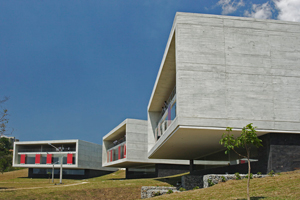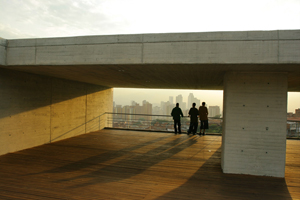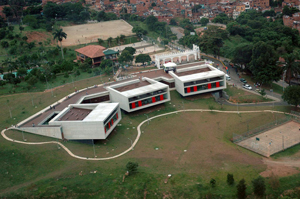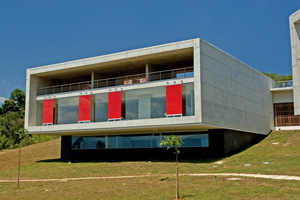 |
 |
 |
 |
 |
 |
| |
 |
|
 |
 |
 |
  |
  |
 |
 |
 |
 |
|
|
 |
|
 |
 |
 |
BUILDING |
 |
|
 |
|
 |
 |
 |
| |
 |
| 
 |
Biblioteca Ladera - León de Greiff
Ladera Library |
|
 |
 |
 |
 |
DESIGNER |
 |
|
|
 |
|
 |
 |
 |
| |
 |
|
 |
 |
 |
 |
DESCRIPTION |
 |
|
|
 |
|
 |
 |
 |
|
|
 |
The aim is to establish a project that enables the largest amount of urban connections and the development of public spaces. To achieve this, there were several proposals such as enabling the roof of the building as public space, empowering meeting places and developing view-points which overlook the city.
|
|
 |
 |
 |
|
 |
|
Zonal Equipment
Management Strategy |
 |
|
 |
 The model allows the employment of public facilities as small open spaced theatres, view-points, small plazas and sport fields when placing them on the rooftop, leaving plain borders as vacuums inside the lot and thus enabling their external use. The model allows the employment of public facilities as small open spaced theatres, view-points, small plazas and sport fields when placing them on the rooftop, leaving plain borders as vacuums inside the lot and thus enabling their external use.
We propose a management program between the EDU and the Culture Secretariat called “Film, Music and Theatre in my quarter”. This will allow the use of the above mentioned roofing as auditoriums so that every two weeks a cultural show can be taken to each quarter.
 The place presents itself as a green viewing-point and a territory of connections between the lower and upper areas of the neighborhood, which are actually used as areas for sport activities. The project we propose will redefine the existing paths and empower the creation of shaded plazas on the library’s rooftop. As a result, it will not only multiply the connections because the building will be an obliged path, but it will create more and more events as people intertwine in the public spaces provided around the library. More than a transformation, we want to re-interpret the space so that it can be recreated into a symbolic place for the city. The place presents itself as a green viewing-point and a territory of connections between the lower and upper areas of the neighborhood, which are actually used as areas for sport activities. The project we propose will redefine the existing paths and empower the creation of shaded plazas on the library’s rooftop. As a result, it will not only multiply the connections because the building will be an obliged path, but it will create more and more events as people intertwine in the public spaces provided around the library. More than a transformation, we want to re-interpret the space so that it can be recreated into a symbolic place for the city.
The project consists of a system formed by three contained, rotated and squared modules that turn, adapting themselves to the landscape and the view and one curved module that unites and relates the other modules and that furthermore allows other uses. The project is a landscape that gives the urban geography continuity through the paths and the building of public spaces on the rooftop, a landscape constituted by paths, theatres or inclined plazas, a spatial network with connection multiplicity and meeting points. |
|
 |
 |
 |
|
 |
|
| Program |
 |
|
 |
 CONTAINER 1 – COMMUNITY CENTER CONTAINER 1 – COMMUNITY CENTER
User: individuals and groups.
Time: 24 hours. Multiple Halls (quarter meetings), my quarter, gymnasium, sieve, technical substation (optimizing the land cut left by housing).
CONTAINER 2 – LIBRARY
User: individual.
Time: From 8am to 8pm. Foyer, reception, catalogue, collection, reading rooms, navigation centers.
CONTAINER 3 – CULTURAL CENTER
User: Organized groups.
Time: Scheduled events. Auditorium, workshops.
CURVED CONTAINER
24 hours.
Can be used as support. Exposition rooms (as obliged paths for all users), cafeteria, management, bathrooms, daycare centres (will be used as kindergardens 24 hours). |
|
 |
 |
 |
|
 |
|
| Credits |
 |
|
 |
Images and text © Giancarlo Mazzanti Arquitectos
Courtesy by Giancarlo Mazzanti Arquitectos
|
|
 |
 |
 |
 |
 |
 |
 |
MATERIALS |
 |
|
|
 |
|
 |
 |
 |
 |
 |
|
reinforced concrete  Each container module is structurally independent from the curved connector. Modules are conformed by screens in the ends to compensate the projection afore mentioned and in the center there are 2 axes of rectangular columns in concrete. The connector is proposed in a network of metallic columns filled with concrete and a retaining wall in stone gabion and concrete in the rear part. Each container module is structurally independent from the curved connector. Modules are conformed by screens in the ends to compensate the projection afore mentioned and in the center there are 2 axes of rectangular columns in concrete. The connector is proposed in a network of metallic columns filled with concrete and a retaining wall in stone gabion and concrete in the rear part.
Vinyl floors in different colors and shapes delimiting pedagogic areas. Visible roofing in white concrete with inferior cake and wooden panels in 5 cm planks. White antique concrete walls. Crystal plates in sandwich with colored resin on the inside to mark and provide some color to the pedagogic areas. The mobile panels of the façade in folded cool rolled planks and curved borders with elements in teka wood.
Following this, the Container Module 1 is thought to have 3 floors, using the tilt of 12 meters left by housing.
|
|
 |
 |
 |
 |
ECO-SUSTAINABILITY |
 |
|
|
 |
|
 |
 |
 |
|
|
 |
 Circulation systems cross air through the mentioned patios, which allow cold air to displace hot air. We propose the emplyment of natural air cooling systems, nurturing the inside of the library with fresh air. In addition to this, we want mobile blinds to cover the windows that face the sunset so that the effect of sunlight can be minimized. Circulation systems cross air through the mentioned patios, which allow cold air to displace hot air. We propose the emplyment of natural air cooling systems, nurturing the inside of the library with fresh air. In addition to this, we want mobile blinds to cover the windows that face the sunset so that the effect of sunlight can be minimized.
On top of the roof view-points we propose planting trees to provide shadow. |
|
 |
 |
 |
 |
 |
 |
 |
LOCATION |
 |
|
|
 |
|
 |
 |
 |

|
 |

|
Continent |
|
 |
  South America |
|
Nation |
|
 |
  Colombia |
|
District |
|
 |
  Antioquia |
|
Province |
|
 |
  Area Metropolitana de Medellín |
|
Town |
|
 |
  Medellín |
|
Address |
|
 |
  Calle 59A # 36-30 - Sector La Ladera - Zona Centroriental
|
|
|
|
 |
|
Telephone |
|
 |
|
Website |
|
 |
|
E-mail |
|
 |
sistemabibliotecas@bibliotecapiloto.gov.co |
|
 |
 |
 |
 |
MAP |
 |
|
|
 |
|
 |
 |
 |
| |
 |
|
 |
 |
 |
 |
|
TYPOLOGY |
 |
|
|
 |
|
 |
 |
 |
Main |
 |
|
 |
ARCHITECTURE | Buildings for cultural activities
Libraries and media libraries
| |
|
|
 |
|
Additional |
 |
|
 |
ARCHITECTURE | Buildings for cultural activities
Art galleries and exhibition areas
Education buildings
Children's museums and pedagogical spaces
Information centres and areas
Commercial buildings
Bars, cafeterias
Urban equipment and structures for public areas
Structures for public areas
| |
 |
 |
 |
 |
CHRONOLOGY |
 |
|
|
 |
|
 |
 |
 |
Project |
 |
|
 |
| 
 |
2005 - 2006
|
|
Realisation |
 |
|
 |
| 
 |
2006 - 2007 |
|
 |
 |
 |
 |
BIBILIOGRAPHIC REFERENCES |
 |
|
|
 |
|
 |
 |
 |
|
 |
Giancarlo Mazzanti, "Saved by the Books", Domus 916, luglio-agosto/july-august 2008, "Architettura/Architecture" pp. 77-84
Sergio Fajardo, "A Real Utopia", Domus 916, luglio-agosto/july-august 2008, "Architettura/Architecture" p. 84 (77-84) |
|
 |
 |
 |
 |
 |
 |
 |
CLIENT |
 |
|
|
 |
|
 |
 |
 |
| |
 |
|
 |
 |
 |
 |
AMOUNT |
 |
|
|
 |
|
 |
 |
 |
| |
 |
|
 |
 |
 |
 |
DIMENSIONAL
DATA |
 |
|
|
 |
|
 |
 |
 |
| Surface |
 |
|
 |
site sq. m. 10.380
gross floor sq. m. 4.200
footprint sq. m. 4.800 |
|
 |
 |
 |
 |
STRUCTURES |
 |
|
|
 |
|
 |
 |
 |
| |
 |
| Sergio Tobón, Alberto Aschner |
|
 |
 |
 |
 |
STAFF |
 |
|
|
 |
|
 |
 |
 |
Project  |
 |
| Giancarlo Mazzanti Arquitectos |
|
|
 |
|
|
 |
|
Design team |
 |
| Andrés Sarmiento, Juan Manuel Gil, Fredy Pantoja, Pedro Saa, Gustavo Vásquez Iván Ucros, Camilo Mora, Alejandro Piña |
|
Construction management |
 |
|
 |
  |
 |
|
|